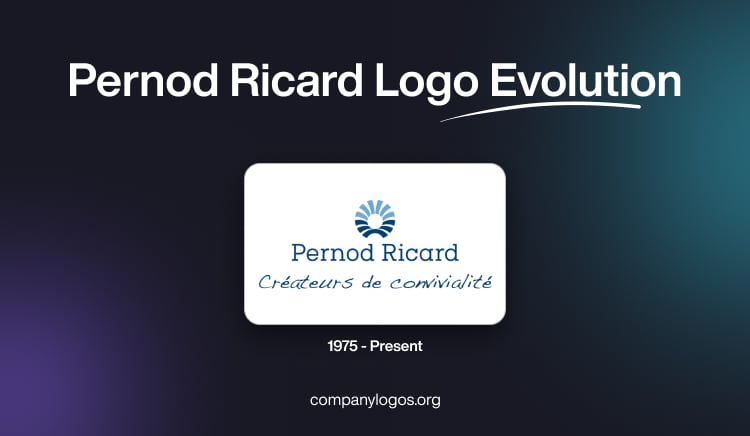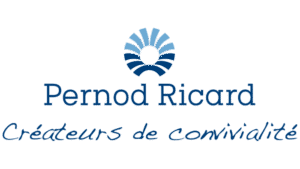
Pernod Ricard is one of the leading spirits and wine companies in the world. It is known for an extensive portfolio of premium brands, including Absolut Vodka, Chivas Regal, Jameson Irish Whisky, and Ricard pastis. The company’s history is rooted in a rich tradition of French distillation and strategic international growth. The logo of Pernod Ricard has not changed since its inception. The article discusses the Pernod Ricard logo, among other details of the company.
The Genesis of the Pernod Ricard Logo (1975 – Present)
The company has had a single logo since it was established in 1975 after the merger of two entities – Pernod and Ricard. The logo is simple, modern, and minimalist. It comprises an emblem and the wordmark. The emblem placed at the top of the logo is a schematic flower called Anise Blossom. It symbolises Ricard and its pastis. The flower has individual petals appearing as stripes that look like excise stamps. Interestingly, the two petals at the bottom merged to form a stripe, which holds the composition together. The union of two petals at the bottom symbolises the merger of two companies, which ultimately formed the foundation of the new entity called Pernod Ricard.
The schematic flower emblem has ten petals arranged in a circle, which symbolise the new entities acquired over the years. The petals are arranged in different directions to show the new companies joining Pernod Ricard from different parts of the globe. To put it succinctly, as the flower opens in various directions, the company distributes its products in various countries (more than 160.)
The brand name below the flower emblem features a clean, modern sans-serif typeface. Also called the Publica Slab light lettering font, the wordmark in lowercase letters reflects approachability and contemporary style. Below the brand name is written “Createurs de convivialite” in French, which translates to “Creators of Conviviality”. In other words, the logo in blue conveys a feeling of friendliness.

The Elements of the Pernod Ricard Logo
Font
The brand name is written using a round, thin, and sans-serif Publica Slab light lettering typeface.
Colour
The logo of Pernod Ricard appears in a blue tone with a gradient that turns from dark to light. The blue colour symbolises heritage, history, smartness, experience, and thoughtful management. The change in gradient from dark to light shows the transformation of the company to a brighter future.
The History of Pernod Ricard
The company derives its name and identity from two separate but similar companies—Pernod and Ricard. Both companies have deep roots in the anise-flavoured spirits business in France.
The origins of Pernod can be traced back to 1805, when Henri-Louis Pernod established one of the first absinthe distilleries in Pontarlier, France. Pernod Fils became known for producing absinthe, a highly popular spirit at the time, until its ban in France in 1915. After the ban, the company reformulated its products and continued producing anise-flavoured pastis.
Paul Ricard, on the other hand, founded his company in 1932 in Marseille, France. He introduced “Ricard”, a pastis that quickly became popular in southern France. Ricard was an innovative marketer and a strong proponent of legalising and popularising pastis. The two companies were major competitors throughout much of the 20th century and offered similar anise-based spirits and built loyal customer bases.
In 1975, Pernod and Ricard merged to form Pernod Ricard by combining their strengths to become a powerful player in the French and international beverage market. The merger allowed the new entity to pool resources for marketing, distribution, and expansion, which ultimately set the stage for global growth.
From the 1980s onwards, Pernod Ricard pursued a strategy of international expansion and acquisition as mentioned below:
In 1988, it acquired Irish Distillers to bring Jameson Irish Whisky into its portfolio. In 2001, it gained control of part of the Seagram portfolio (including Chivas Regal) after the breakup of the Seagram spirits business. In 2005, one of the most transformative moves came with the acquisition of Allied Domecq, which added major brands like Malibu, Beefeater Gin, and Kahlúa. And in 2008, Pernod Ricard acquired the iconic Absolut Vodka brand by purchasing the Swedish company Vin & Sprit. These acquisitions turned Pernod Ricard into the world’s second-largest wine and spirits group, just behind Diageo.
In recent years, Pernod Ricard has placed strong emphasis on sustainability, digital transformation, and responsible drinking. The company has committed to achieving ambitious sustainability goals under its “Good Times from a Good Place” initiative. It addresses carbon emissions, water use, and community engagement. Based in Paris, Pernod Ricard operates in more than 160 countries. It boasts a wide portfolio that has spirits from every major category. The company is listed on the Euronext Paris exchange and is a component of the CAC 40 index.
Interesting Facts About Pernod Ricard
- Pernod Ricard traces its origins to 1805, when Henri-Louis Pernod founded Maison Pernod Fils in France, originally producing absinthe. Ricard, the other half of the company, was established in 1932 by Paul Ricard, who created a refined version of pastis, an anise-flavoured spirit.
- The company as it exists today was formed in 1975 by the merger of two fierce competitors, Pernod and Ricard. This move created a global powerhouse in the world of spirits.
- The original venture of Pernod was absinthe, a drink so popular that it was called the “national drink” of France until its ban in 1915. The company then moved to producing anise-flavoured liqueurs, which remain a signature product.
- Pernod Ricard distributes its brands in more than 160 countries and operates 94 production sites across 24 countries. This makes it the second-largest wine and spirits company in the world.
- The group owns and distributes over 240 premium brands. These include names like Absolut Vodka, Jameson Irish Whisky, Chivas Regal, The Glenlivet, Ballantine’s, Havana Club, Beefeater, Martell, Malibu, Jacob’s Creek, and Ricard Pastis.
- Pernod Ricard is a leader in sustainability. Since 2010, it is credited with reducing its CO₂ emissions by 17.5% and water consumption by 27%. Its “Grain to Glass” and regenerative agriculture initiatives are transforming its environmental impact, especially in key markets like India.
- The Ricard family remains closely involved in the company. Alexandre Ricard, who is also the grandson of founder Paul Ricard, became the CEO in 2015.
- India has become the second-largest market for Pernod Ricard by sales and has surpassed China. The company considers India, the US, and China as its “must-win” markets.
- Since its founding, Pernod Ricard has grown through major acquisitions. These include Irish Distillers (Jameson), Orlando Wyndham (Jacob’s Creek), Seagram’s (Chivas Regal, The Glenlivet), Allied Domecq (Malibu, Ballantine’s), and Vin & Sprit (Absolut Vodka).
- Pernod Ricard employs nearly 19,000 people worldwide and has 81 offices in countries across the globe, from the USA to China, Croatia, and Vietnam.
- Pernod and Ricard pastis remain cultural icons in France. They are often associated with the ritual of mixing with water and ice to create a cloudy, refreshing drink.
Finally
The Pernod Ricard logo shows how the company began its journey from two historic French distilleries to a global leader in the wine and spirits industry. The combined logo of Pernod Ricard reflects changes in design trends, corporate values, and market positioning. The use of a distinctive colour and clean, modern typography underscores Pernod Ricard’s commitment to growth, quality, and sustainability in its brand expression.